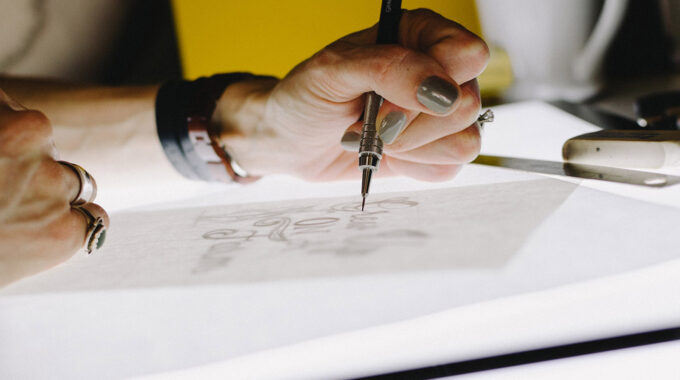Why You Need a Strong Logo Design Creative Brief

A logo is a critical piece of a business brand. And it is often the best reminder to consumers of what that company is and the products or services it offers. A logo must reflect the brand image in many ways – its essence (conservative, traditional, progressive, revolutionary), colors, typography, artistic design features, etc.
As a graphic designer, it is your job to capture all of these elements in a single piece, and that can be pretty tough.
Obviously, lots of discussion between you and your client needs to occur.
The Reluctant Client
“Reluctant” is probably not the correct term here. But it is difficult for many clients to provide the kind of information you really need to create a logo that perfectly reflects his brand. You are the one who must be in charge of getting the right information through a full discussion.
That discussion you hold with your client is often called a “briefing.” And from it you need to get key information about his business, the market place, his customer persona, and more.
Having that complex discussion can be successful if nothing is left out. And as they verbally speak about their company, products, and customers, business owners will expect that you will be the one taking the notes, so that you have all of the information you need. After all, you are the expert here. And this just the way a lot of designers actually handle this discussion.
Your notes become the “design brief.”
To the Drawing Board with Your Notes
Armed with your briefing notes, you set about your task. And as you move into that process, you discover that your notes have left some holes in the information you need. You didn’t get the client to expand enough in one or more of the key areas of discussion, and you now must go back for more detail.
This problem is more common than not, as you well know. And it does stall your work and possibly causes revisions in what you have already accomplished – those ideas that have been floating around in your head and/or some preliminary sketching you have already done.
The Solution
You need all of the key detail up front so that there are no “stalls” in your work. And to do this, you need to develop a format for a written brief that will garner all of the details up front and reduce your need to go back to the client until you have some actual design options for him.
Why You Need a Design Brief
There are two things that design brief accomplishes if it is formatted correctly to get those details you need:
- You Have a Written Record. This is perhaps the most important reason to have that design brief. Consider this: You have multiple clients for whom you are designing logos at any one time. And you may have design projects other than just logos. It’s easy as you are on a roll working to forget some of the details of one project or to become a bit confused. If you have a written brief, you will not forget or confuse things.
- All of the details are covered. When both client and designer have a copy of the design brief, nothing is left to chance or misunderstanding. There is a clear format for what was discussed. And you will not have to contact your client for further clarification – this kind of communication causes a client to lose confidence in you. In short, both of you are on the same page.
Your Three Options
Once you have your brief questions/points crafted, you do have two options.
- You can submit it to your client for him to fill out. A lot of designers like to use this option because it forces the client to really think through what his brand needs to say to a consuming audience and exactly who that consuming audience is, etc.
- You can complete the form during a verbal discussion with your client. This allows you to put your own creative interpretation on some of the items as they are discussed.
- Or, you can do a combination brief construction. You can have the client complete the brief first, submit it to you, and then you can have the discussion following your analysis of the submitted brief.
Finding the Balance
The length of your design brief is a pretty big factor if you are asking the client to complete it. Most of the questions will be a bit open-ended, and you don’t want to overwhelm them. These are business owners who are busy and may be uncomfortable trying to get their thoughts down on writing – sort of like the bright college student who employs a writing service, such as Trust My Paper, because he cannot transfer his great ideas to clear text.
If your brief is long, a client can be somewhat turned off and think, “This is what I hired this guy for.” On the other hand, if the brief is too short, you will not get the detail you need, even though your client may be happier.
You have to find the right balance here. It is probably a good idea to keep your design brief to a single page. And if you fashion your questions carefully, you will have the information you need.
The Questions
In some form or another, the following questions should be included in your logo design brief.
- Name to Be Used in the Logo
There are a lot of options here – the company name, the product name (if it is different from the company), possibly just initials, or no name whatsoever. Consider, for example, Microsoft’s logo.
Sometimes it is accompanied by the word, “Microsoft;” other times it is not.
But Microsoft is a universally known company, so using the name can be optional.
Not so with your client. You need to have an official business name, product or service name, etc. And your client needs to state a preference – company name, initials, etc.
- Does the client want some type of slogan/tag line?
The client may indeed want some type of slogan but may not have an idea for that slogan. That may be up to you. In order to come up with that slogan, your client will need to explain the mission of the brand. For example, if your client sells paint, a slogan should relate to what that paint can do for its customers.
Think about GE, for example. For years, its slogan was “We bring good things to life.” After 2003, it changed to “Imagination at Work.” Large enterprises often change their tag lines, but the key for you will be to come up with one that expresses the brand image/mission.
- Details about the product or service
This is the one question that will require some in-depth information from your client. You don’t have the intimate details about the product(s) or service(s) that the company offers for sale. The business owner, of course, does. You want as much detail as possible, especially as you create a design and/or a slogan that will be a “fit.” You cannot just let a client get away with a statement like “I sell gardening supplies.” You need to know what kind of supplies, what value they offer to customers, what is unique about those products that sets them apart from the competition.
- The Target Customer
This is a pretty critical piece of the design “pie.” There is a big difference between designing a logo that would appeal to a senior citizen audience looking for back braces and one that would appeal to Gen Z’ers looking for fitness gear. You need to know the demographics of the target audience so that all that you include in your logo design appeals to that audience. There is a reason that Nike has its infamous “swoosh,” representing the Greek goddess of victory, also named Nike. It symbolizes the movement. And no matter what slogans may be added to that design (e.g., “just do it”), that design symbol remains. It appeals to a young audience.
- What distinguishes the company or its products/services from others in the same industry? How do you want to be known within your industry?
This question is usually difficult for a client to answer. It forces him to dig a bit deeper into his thinking and to determine what it is his brand wants to be known for. And it relates directly to any tag that is added to the actual design.
If a client sells jewelry, for example, are they high-end expensive products or are they produced for a young audience on the go and seeking a more informal look at reasonable pricing? This will definitely impact that logo. Consider the Rolex brand logo vs. a more progressive Allison Lou, for example. One is formal and conservative, in black, gold and silver; the other is kicky and contemporary. The jewelry industry is huge, but within that sector are all kinds of levels of sophistication and pricing.
- Have you made any preliminary decisions about what you want? Colors? Full company or product name? Initials? Any preliminary drawings? Slogans?
Here, the client should let you know if he has thought about this in advance and has some ideas of his own. These can drive some of your design decisions.
Clients may be at all different points in this process. Take what they have to offer and see how you may be able to incorporate those ideas into your design options.
- Is there a timeframe?
Clients will be all over the place on this one. Some may want some options as quickly a possible; others are more slow-moving and are willing to let you take your time. But a general timeframe is important so that you can fit their project into your schedule. And timeframe will also impact your pricing.
There you have it. You should be able to get all of the detail you need with these seven questions, and your client will not feel overwhelmed if you should ask him to fill out the brief. If nothing else, his input will give you the information you need for further discussion to get all of the information you need to move forward. Get it in writing. You will be thankful you did.







